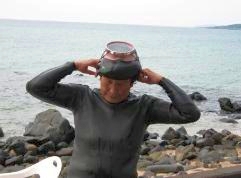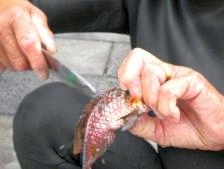By Jennifer Barclay, author of Meeting Mr Kim: Or How I Went to Korea and Learned to Love Kimchi (www.authorsites.co.uk/jenniferbarclay) October 2009
The morning air is humid and salty, the sea calm, a silvery blue. The beach is so close I canÂ’t resist a swim. As I turn towards Jungmun, where dunes covered in lush green foliage trail down to a soft pale sand beach, I spot the diving women like seals in their black wetsuits, out in the ocean off the sharp black rocks, visible by the orange buoys from which they suspend the catch. They come up for air every couple of minutes, then dive back down again. One is walking up to shore, carrying a heavy net sack filled with shellfish on her back.
The haenyeo, or women divers, have been diving for abalone, sea urchins, sea snails and other seafood here on South KoreaÂ’s Jeju Island for over three centuries. While the men went to sea in fishing boats, women learned to dive, sometimes from the age of six. ItÂ’s a dying culture, however. There are still 5,000 women divers in Jeju, but their average age is 65; young women are no longer learning the skills required to dive all day without oxygen tanks to depths of ten metres or more.
Although I visited the haenyeo museum, I didn’t expect to see the female divers themselves, just around the corner from my hotel. I came to Jeju to walk in the lava tubes and up the dormant volcano of Hallasan, both UNESCO world heritage sites. The forest-covered national park covers a large part of the island and is Korea’s biggest ecological treasure. Semi-tropical Jeju, the biggest of the islands and known as the Hawaii of Korea, has a population of half a million, and has been a self-governing province since 2007. Popular with visitors from China and Japan – and Philippinos, who come here to see snow in the winter – it is barely known to the west, and yet English is widely spoken. ‘We love having you here’ say signs in English everywhere. Except for July and August, the beaches are practically empty, while activities include walking the coastal paths, golfing, horse riding and attractions such as the ‘humorous theme park’ Love Land.
Meanwhile, in spite of all this twenty-first century activity, the haenyeo divers survive mainly through their wits and the strength of their communities. In the old days they would build a shelter and a fire, and in the evenings the older women would pass on their skills to the younger women. Although wetsuits have replaced the cotton suits they used to wear (with adjustable buttons for diving when pregnant), they still dive without breathing apparatus, going down ten to twenty metres for one or two minutes. Surfacing, they let out a whistle-like shriek to exhale the carbon dioxide and take in oxygen for a minute before diving again.
These incredibly strong women haul in their catch on the rocks, then still dressed in wetsuits theyÂ’ll hustle in a good-humoured way for customers here by the beach. Go In-ho is the oldest haenyeo in this community. She started at fifteen years old, and has been diving for seventy years. She looks hale and hearty.
‘If my health stays good,’ she says, ‘I’ll keep going for another five years.’ For eight days she works here, and for eight days she works in the barley fields. Jeju-do cannot grow rice and its fields are protected from fierce storms by dry-stone walls built with volcanic rocks. The island is known for its ‘three plenties’: wind, rock and women. The men didn’t always come home from fishing on the treacherous seas around Japan and Russia.
Tables are set out right by the water’s edge, and several customers are already eating and drinking at 10 a.m. One of the haenyeo in a heavily patched and darned wetsuit takes a fish from a bucket, de-scales it and slices it up with a sharp knife, cleaning the board with a hose. She pulls out an octopus, hacks off the black ink sack and puts it in a pot on a little stove. Here’s your locally sourced food, freshly prepared – it doesn’t get much fresher. The chef’s kitchen is right here at your feet. Having served the food she takes the banknotes and stuffs them into the diving mask on her head.
We sit down, and Go In-ho gives us a plate of whelks, which Dami shows me how to wind out of their shells using a toothpick.



In the UK weÂ’ve got perfectly accustomed to eating sashimi when itÂ’s cut into soft pink and white squares, but Korean raw fish restaurants always look more like pet shops, piled with bubbling tanks where odd-looking creatures lurk and writhe. The fish in the tubs here, meanwhile, barely notice theyÂ’re out of the water before theyÂ’re chopped up and on a plate. We take a small snapper, which comes still with skin and a few little bones, but Koreans arenÂ’t fussy about that. And we eat white slices of raw squid head with sesame oil.
I’ve vowed to be adventurous on this trip. I look into the tank and can’t bear to ask for the octopus, although I love it. Koreans eat baby octopus while it’s still alive, which seems unnecessarily cruel to me (‘Yes, but very tasty,’ according my guide). No, it’s time to conquer my fear of one of Korea’s favourite seafoods: sea cucumber, which looks like a big fat spiky caterpillar.
I try not to watch as In-ho squats on her haunches, grabs a sharp knife and firmly chops up the little black creature, removing its white insides. And suddenly there it is, plated up on the table. I daub a piece liberally with hot sauce. ItÂ’s a bit like oyster, really. Once you get over the idea of it, itÂ’s like eating a raw taste of the ocean. Not bad at all. And when you think itÂ’s been caught by a woman whoÂ’s been free-diving for seventy years, you feel like a bit of a wuss being squeamish.
According to the folk rites, Yeongdeung Halmang, the guardian goddess, visits Jeju-do on the first day of the second lunar month to sow the seeds of the sea creatures, and every year shamans still perform ceremonies here. Although in many ways South Korea is more advanced and prosperous than much of Europe (the most connected country in the world with the fastest broadband, a subway system in Seoul where you can use your mobile phone), they are fiercely proud of their traditional heritage. So it is sad that women are no longer learning to dive, although IÂ’m sure there are easier ways to earn a living. I go for my swim and wonder what itÂ’s like in a wintry storm.
